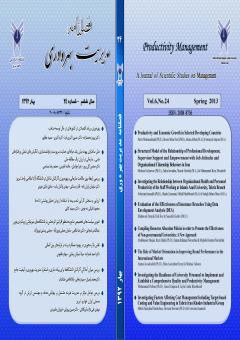Evaluation of the Effectiveness of Insurance Branches Using Data Envelopment Analysis (DEA) (Case study: Branches of Insurance Company in the Southern Provinces of Iran)
Subject Areas : Business ManagementMahmood Dniyali dah hooz 1 , Saede Ketabi 2
1 - Faculty Member (instructor) Islamic Azad University, Izeh University, Ph.D. Student of Business Management, University of Isfahan
2 - Associate Professor, Isfahan University, Isfahan-Iran
Keywords: DEA, Performance Measurement, Iran insurance branches,
Abstract :
Evaluation of the effectiveness of organizations has always been the concern of researchers. Hence, over the years numerous techniques for doing this have been proposed and used. One of the techniques that is widely used in various research areas and a high proportion of related scientific evaluation is data envelopment analysis (DEA). Besides, the insurance industry as a growing industry in the country has attracted the attention of researchers and administrators. Among the various issues in this area is the problem of performance evaluation and performance indicator. Because of the small amount of performance and its comparison in various branches and units, we can investigate different procedures in increasing the efficiency of the insurance branches and the steps taken to improve it. This study uses data envelopment analysis to measure the efficiency of insurance branches and after recognizing the efficient and inefficient offices by using technical tools, we have introduced the factors that are responsible for inefficiency of ineffective branches and finally we have presented some practical solutions to improve the performance of the insurance units.
Banker, R.D. Charnes, A., Cooper, W.W., (1984), Models forEstimating Technical Scale Efficiencies in Data EnvelopmentAnalysis, Management Science, Vol.30, P1078-1092.
Bowlin, W.F (1998) Measuring Performance: an Introduction toData Envelopment Analysis, Journal of cost analysis
Charnes, A., Cooper, W.W., Rhodes (1984), Measuring theEfficiency of Decision Making Units, Journal of Operation ResearchNo.2, P 429-444.
Cummins. J.D., H. Zi,(1999),” Comparison of frontier efficiency methods: an application to the US life insurance industry”, Journal of Productivity Analysis No 10.pp 131–152.
Cooper, W.W. L.M. Seiford, K. Tone, Data Envelopment Analysis, (2000),” A comprehensive Text with Models, Applications, References andDEA-Solver Software”, Kluwer Academic Publisher.
Charnes. A., C.T. Clark, W.W. Cooper, B. Golany,(1985),”A development study of data envelopment analysis in measuring the efficiency ofmaintenance units in the US air forces”., Annuals of Operations Research 2,pp 95–112.
Cooper, W.W., Deng, H. Huang, Z.M. (2002), A Non-ModelApproach to Congestion in Data Envelopment Analysis, Socio-Economic Planning Sciences, No.36, pp231-238.
Daneshvar, M., Azar, A., & Zali, M. R. (2006). Designing a Performance Evaluation Model for Insurance Branches Using Data Envelopment Analysis (Case Study: Dana Insurance). Journal of Humanities and Social Sciences, 6(23), (In Persian).
Falah, M. (2007). Assessing the Effectiveness of Insurance Branch Branches by Data Envelopment Analysis. New World Insurers, 115 & 116, (In Persian).
Fecher. F., D. Kessler, S. Perelman, P. Pestieau,(1993),” Productive performance of the French insurance industry, Journal of Productivity Analysis 4, 77–93.
Gardner. L.A., M.F. Grace, (1993),”X-efficiency in the US life insurance industry, Journal of Banking and Finance 17, 497–510.
Hannah.E, V. Yeung,(1998),” Report of the Task Force on the Future of the Canadian Financial Services Sector”, Financial Regulation Report, London, October.
Imami Meybodi, A. (2000). Principles of Measurement of Efficiency and Productivity. Tehran: Institute for Business Studies and Research, (In Persian).
Javaher Dashti, F. (2004). Examining the Country's Insurance Industry from the Past to the Present Day. Tadbir Monthly, 147, (In Persian).
Rezaei, A. (1999). Performance Evaluation of Performance of Insurance Companies Branches by Data Envelopment Analysis. Insurance Research Journal, 54. 34-45, (In Persian).
Yuengert. A.M., (1993), “The measurementof efficiency in life insurance: estimates of a mixed normal-gamma error model, Journal of Banking and Finance 17 ,483–496
_||_Banker, R.D. Charnes, A., Cooper, W.W., (1984), Models forEstimating Technical Scale Efficiencies in Data EnvelopmentAnalysis, Management Science, Vol.30, P1078-1092.
Bowlin, W.F (1998) Measuring Performance: an Introduction toData Envelopment Analysis, Journal of cost analysis
Charnes, A., Cooper, W.W., Rhodes (1984), Measuring theEfficiency of Decision Making Units, Journal of Operation ResearchNo.2, P 429-444.
Cummins. J.D., H. Zi,(1999),” Comparison of frontier efficiency methods: an application to the US life insurance industry”, Journal of Productivity Analysis No 10.pp 131–152.
Cooper, W.W. L.M. Seiford, K. Tone, Data Envelopment Analysis, (2000),” A comprehensive Text with Models, Applications, References andDEA-Solver Software”, Kluwer Academic Publisher.
Charnes. A., C.T. Clark, W.W. Cooper, B. Golany,(1985),”A development study of data envelopment analysis in measuring the efficiency ofmaintenance units in the US air forces”., Annuals of Operations Research 2,pp 95–112.
Cooper, W.W., Deng, H. Huang, Z.M. (2002), A Non-ModelApproach to Congestion in Data Envelopment Analysis, Socio-Economic Planning Sciences, No.36, pp231-238.
Daneshvar, M., Azar, A., & Zali, M. R. (2006). Designing a Performance Evaluation Model for Insurance Branches Using Data Envelopment Analysis (Case Study: Dana Insurance). Journal of Humanities and Social Sciences, 6(23), (In Persian).
Falah, M. (2007). Assessing the Effectiveness of Insurance Branch Branches by Data Envelopment Analysis. New World Insurers, 115 & 116, (In Persian).
Fecher. F., D. Kessler, S. Perelman, P. Pestieau,(1993),” Productive performance of the French insurance industry, Journal of Productivity Analysis 4, 77–93.
Gardner. L.A., M.F. Grace, (1993),”X-efficiency in the US life insurance industry, Journal of Banking and Finance 17, 497–510.
Hannah.E, V. Yeung,(1998),” Report of the Task Force on the Future of the Canadian Financial Services Sector”, Financial Regulation Report, London, October.
Imami Meybodi, A. (2000). Principles of Measurement of Efficiency and Productivity. Tehran: Institute for Business Studies and Research, (In Persian).
Javaher Dashti, F. (2004). Examining the Country's Insurance Industry from the Past to the Present Day. Tadbir Monthly, 147, (In Persian).
Rezaei, A. (1999). Performance Evaluation of Performance of Insurance Companies Branches by Data Envelopment Analysis. Insurance Research Journal, 54. 34-45, (In Persian).
Yuengert. A.M., (1993), “The measurementof efficiency in life insurance: estimates of a mixed normal-gamma error model, Journal of Banking and Finance 17 ,483–496


